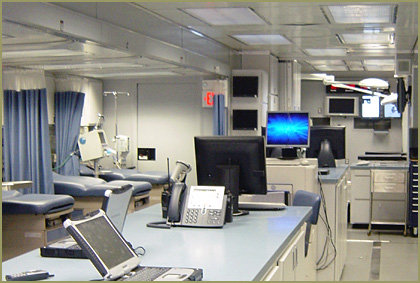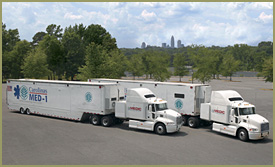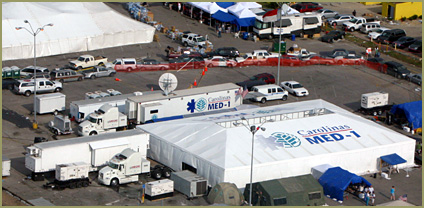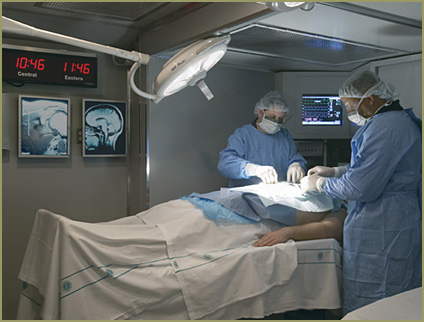Going High-Tech to Meet Preparedness Challenge
July / August 2007
Going High-Tech to Meet Preparedness Challenge

![]()
Photo courtesy of Carolinas HealthCare System
To confront this array of threats, public health officials find themselves faced with the daunting task of adapting old disaster response policies to newly emerging dangers. After the events of September 11, 2001, the state of North Carolina began to realize that the old ways simply wouldn’t work. As with many states, ours undertook a far-ranging reappraisal of its disaster response efforts, particularly the difficult question of how best to provide on-site medical care following a natural or man-made disaster. The result of our efforts was the creation of the MED-1 mobile healthcare facility, a virtual hospital on wheels — outfitted with the cutting-edge in health technology — that could deliver timely, effective care under the most demanding of circumstances.
New Threats, New Responses
From the late ’80s to the early ’90s, response strategies in the United States were focused primarily on determining the best and most efficient means of evacuating large numbers of people from a disaster area, or quarantining infectious populations in a hot zone. Many plans did not take into account factors such as a panicking public compromising the sterile hospital environment or the need to expand hospital-bed capacity at a moment’s notice.
Then, in 1995, terrorists unleashed deadly sarin gas in the Tokyo subways, killing 12 commuters, injuring more than 1,000 others, and causing a panic that overwhelmed local hospitals with more than 5,500 citizens seeking treatment and screening. Six years later, anthrax-tainted packages found their way into the offices of major U.S. news media outlets and governmental buildings, creating a scare that reverberated throughout Capitol Hill.
These frightening events were a wake-up call to the public health community. They exposed the all-too-real premise of substantial bottlenecks at emergency rooms should a natural or man-made disaster occur on a massive scale. And if such an attack were chemical or biological in nature, public health providers would face the additional burden of sealing off emergency rooms to separate the sick from the uninfected.
The critical need to answer these questions came to the attention of Dr. Thomas Blackwell and his colleagues at the Carolinas Medical Center Level 1 Trauma Center in Charlotte-Mecklenburg, North Carolina. Blackwell, an attending ER physician as well as medical director for the Mecklenburg Emergency Medical Services Agency, had years earlier envisioned a mass-transit vehicle to ferry victims from dangerous areas to secure locations. Following the Tokyo sarin incident, the need to expand this mandate became clear to Blackwell, but at that point the funding or support for such a project did not exist.
 Photo courtesy of Carolinas HealthCare System |
|
It wasn’t until after 9/11 that development of the facility — which was to be called Carolinas’ mobile emergency department, or MED-1 — came to fruition. Just as the 2001 attacks demanded a wholesale reappraisal of the nation’s approach to disaster readiness, the attacks were a catalyst for us to get MED-1 up and running to serve North Carolina and the surrounding region.
Bringing the Hospital to the Patient
With a grant from the Department of Homeland Security, Blackwell and his colleagues at Carolinas began construction on a healthcare facility that would revolutionize the way we approach local, statewide, and regional disasters. The facility would essentially become a fully functional, mobile ER that could be deployed to quickly expand hospital services, or move infected populations away from high-density areas.
Consisting of two 53-foot tractor trailers — one vehicle for patient care, one vehicle for support and storage — the MED-1 mobile healthcare facility features six critical-care beds, seven general beds, one dental/ENT chair, and a fully functioning pharmacy stationed within nearly 1,000 square feet of indoor treatment space. After deployment to the field, the tractor trailers are transformed and can begin accepting patients within 20 minutes. To expand our footprint, we designed a tent system that can be deployed within an additional 6 hours to add up to 130 beds for non-critical patients.
The facility’s capabilities are extensive, ranging from laboratory, radiology, and ultrasound diagnostics to critical cardiac and respiratory care, to operative procedures required for life-saving hemorrhage control.
Putting Theory into Practice
Despite its broad range of capabilities and the paradigm shift that it represented in disaster preparedness, some members of Carolinas Medical Center were initially skeptical that MED-1 could perform under the demanding situations of an actual disaster scenario. As the facility sat unused after its completion in 2004, it earned the nickname the “white elephant” by some dubious physicians. All of those perceptions changed radically, however, after Hurricane Katrina made landfall in 2005.
As the Gulf Coast reeled from the effects of the storm, providing healthcare to thousands of displaced, injured, and severely ill citizens became a daunting task. Many primary healthcare facilities in the region were damaged or totally unusable, and those hospitals that weathered the physical impact of wind and water were overwhelmed by the massive number of victims seeking treatment. FEMA approached Carolinas Medical Center, and in conjunction with the North Carolina Office of EMS, a deployment was authorized. MED-1 was moving on what would prove to be its first — and defining — mission.
Drawing staff from 128 regional hospitals, we dispatched caregivers in rotating weeklong shifts at the facility’s deployment outside Waveland, Mississippi, over the course of 41 days, providing care to thousands of patients by dispensing vital medications, treating wounds, and performing minor surgeries. Manned by teams ranging from 75 to 92 staff members, the facility served as the only critical care facility in the area. By the end, those few of us who had remained for the duration of the deployment were exhausted but impressed with how capably MED-1 had performed under such demanding circumstances. When we returned home, no one mentioned anything about white elephants.
Six months after MED-1’s successful tour during Katrina, the U.S. Department of Health and Human Services and the city of New Orleans asked us to expand their ability to provide medical care to the rebuilders and revelers who were expected to descend on the city during Mardi Gras. Despite a half year of rebuilding efforts, the city’s healthcare facilities were still severely strained, and the primary hospital in the downtown district was still shuttered. Patients were encountering up to 10 hours of wait time in local emergency rooms and 36-hour delays for hospital beds. Clearly, additional services were needed before the influx of tourists arrived.
Louisiana State University fulfilled the majority of our laboratory and caregiver staffing needs for the deployment, with additional services provided by North Carolina’s Disaster Medical Assistance Team, one of 55 rapid-response medical-support units around the country created by DHHS to respond when national disasters strike. Again, the MED-1 teams distinguished themselves by providing a level and quality of care to the still ravaged city of post-Katrina New Orleans.
After two highly successful tours of duty, there were plenty of congratulations in the hallways of the Medical Center. But beneath the sense of satisfaction we all felt in the facility and ourselves, the deployments had highlighted areas in which we could improve MED-1’s capabilities. After months in the field, we knew the stumbling blocks. The only question was how we would overcome them.

![]()
Carolinas MED-1 deployed to New Orleans in March 2006 to expand local medical service during Mardi Gras.
Photo courtesy of Carolinas HealthCare System
Expanding Capabilities, Enhancing Safety
Although MED-1’s original IT hardware was fully functional, the facility’s lack of updated equipment posed a number of significant obstacles. Our workstations were aging and inefficient, operating on slower processors that dulled the response efforts of our attending caregivers. No established communications system existed to quickly and effectively contact physician staff in the event of an emergency situation. Most importantly, MED-1 lacked a patient records system to capture treatment protocols and analyze deployment metrics. The entire MED-1 team recognized these limitations and their affect on clinical operations, but we had neither the time nor the financial resources to address them.
MED-1’s successful deployments during Katrina relief efforts earned the mobile facility worldwide media coverage, which brought us to the attention of CDW Healthcare, a technology solutions provider based in Vernon Hills, Illinois. CDW approached us in 2006 to discuss how their organization could help us enhance our IT capabilities to provide safer, more effective patient care.
CDW Healthcare filled the gap in funding and capabilities by donating critically needed hardware and services to the MED-1 facility. Working with our entire team to identify the areas where upgrades were needed most, CDW Healthcare’s technology specialists installed voice-over IP (VoIP) communications, a positive patient ID tracking system, picture archiving and communications system (PACS) technology, and ruggedized wireless computers for patient admission outside of the internal treatment space. These new platforms have significantly enhanced MED-1’s ability to provide efficient, quality patient care.
The VoIP, for example, has revolutionized our ability to communicate in the field. Before the technology upgrade, our teams relied on walkie-talkies to communicate with one another. Problems with this system became apparent soon after our Waveland deployment. MED-1’s expansion tent includes an area for staff quarters, where off-duty or on-call staff can refresh before resuming work. Walkie-talkie technology broadcasts all two-way communications traffic, so exhausted team members in the staff quarters often lowered the volume or shut down their handset to catch some quiet rest before the next shift. If we then tried to reach them over the handset, they wouldn’t respond. We were eventually forced to visit quarters and shake each of our sleeping team members awake before we found the right one. Clearly, this is not an ideal system in a disaster-response arena, where we are expected to react quickly to emergencies.
With VoIP, on-call staff members are handed a cellular phone that we can dial from the field. The system is consistent, reliable, and direct. We don’t need to rely on cell towers or land lines — the central VoIP platform resides on the MED-1 truck and can reach associated cell phones within a several-mile radius. Now, when the cell phone rings and awakens a sleeping team member, he or she will know precisely who that call is for.

![]()
Performing surgery in the Carolinas MED-1 mobile healthcare facility.
Photo courtesy of Carolinas HealthCare System
Another major upgrade replaced an inefficient paper-based patient tracking system that was vulnerable to errors. ER physicians know well that in the fast-paced environment of emergency care, maintaining an accurate record of provided and recommended treatments is absolutely essential to ensuring patient safety. We worked with CDW Healthcare to implement a positive patient-ID tracking system, which uses barcoded wristbands to monitor an individual’s progress through multiple points of care. From admission to discharge, we can pinpoint the precise location of a given patient within the entire MED-1 facility, produce a detailed record of all received and prescribed treatments, and assist staff in flagging possible drug interactions, allergies, and contraindications. MED-1’s ability to track and catalogue patients is so cutting-edge, in fact, that most larger intensive care hospitals are only now beginning to investigate the benefits of this technology.
In order to maximize the speed and accuracy of the admissions process, we wanted to enable the nursing staff to capture patient data electronically throughout the primary and secondary care areas. To accomplish this, we placed powerful hardware in their hands, including ruggedized tablet PCs and laptop carts linked to our patient ID tracking system. No longer bound to fixed workstations, our caregivers can now work freely through the field, entering and updating patient records as needed into our single, unified database.
To provide an electronic record of all imaging scans conducted in the MED-1 diagnostic facility, we worked with CDW Healthcare to establish a PACS system to capture and display patient data. State-of-the-art diagnostic-quality LCD monitors installed on the MED-1 truck, coupled with high-performance networking and storage hardware, will provide attending physicians with X-ray and CT scans at the touch of a button. The addition of DICOM-compliant CD burners will allow attending staff to provide patients with an easily portable and highly detailed record of all imaging data gathered during their transit through the facility — a valuable capability that will facilitate continued care should a patient require transfer to a nearby hospital.
While none of us is eager to see MED-1 deployed again anytime soon, we are confident that if disaster strikes and we’re called to assist, we’ll be able to provide the best possible acute care in a field-hospital setting. We are hopeful that MED-1 will serve as a prototype — as well as an inspiration — for other healthcare organizations to devote resources for the construction of other mobile critical-care units all over the U.S. As emergency responders, we are accustomed to the unpredictable. Preparation is our best defense.
Jerry Morris, a trained paramedic, serves as the clinical faculty and operations manager for MED-1 at the Carolinas Medical Center in Charlotte-Mecklenburg, North Carolina. Previously, Morris was clinical services manager with Rural Metro Ambulance Service of Alpharetta, Georgia, and EMS director and senior instructor for the United Arab Emirates Military Medical Upgrade Project, which designed and implemented the capabilities of a modern medical system in one of the fastest growing countries in the Middle East. Morris has a bachelor’s degree from the University of North Carolina Fayetteville and is a member of numerous professional registries and associations, including the National Registry of Emergency Medical Technicians and the National Association of EMS Educators. He may be contacted at froglegz57@yahoo.com.
